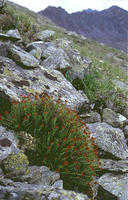You are in: Asia -> Mongolia -> Uvs Nuur Basin, and traditional search or Image Gallery will yield results of this site only
Uvs Nuur Basin
| Site number: | 769 |
|
| Type of site: | Natural | |
| Date: | - | |
| Date of Inscription: | 2003 | |
| Location: | Asia, Mongolia and the Russian Federation, Uvs Aimag, Zavhan Aimag, Huvsgul Aimag (Mongolia) | |
Up to 75 images are shown here. Click on each for more details or on Image Gallery for more images.
| Description: | The 1,068,853 ha Uvs Nuur Basin is the most northern of Central Asia’s enclosed basins. Its name stems from the Uvs Nuur Lake, an immense, shallow and incredibly salty lake - vital for migrating birds, waterfowl and seabirds. The site consists of twelve protected areas denoting eastern Eurasia’s major biomes. The steppe ecosystem sustains a prosperous diversity of birds and the desert supports rare gerbil, jerboas and the marbled polecat. The globally endangered snow leopard, mountain sheep (argali) and the Asiatic ibex find a significant safe haven among the mountains. --WHMNet paraphrase from the description at WHC Site, where additional information is available. | |
| Uvs Nuur (Mongolian: Увс Нуур; Tuvan: Убсу-Нур, Ubsu-Nur, English Lake Uvs) is the largest lake in Mongolia, which, at 753 m above sea level, covers an area of 3,350 km². Its northeastern part is situated in the Tuva Republic of the Russian Federation. The largest settlement on the shore is Ulaangom. This shallow and very saline body of water is the only remainder of a huge saline sea which covered a much larger area several thousand years ago. The Uvs Nuur Lake is the centre of the Uvs Nuur Basin, which covers an area of 700,000 km² and represents one of the best-preserved natural steppe landscapes of Eurasia. Here the world's most northern desert meets the world's most southern tundra zone.Apart from the Uvs Nuur, the basin comprises several smaller lakes, notably the Üüreg Nuur Lake, which lies at 1,450 m above sea level. As these lakes lie to the north of other inland seas of Central Asia, they are of key importance for waterfowl migration. Despite its harsh climate, the depression is home to 173 bird species and 41 mammal species, including the globally endangered snow leopard, argali, and Asiatic ibex. The population density is low here. The lack of industry and the reliance of the inhabitants on traditional ways such as nomadic pasturing have little impact on the landscape and allow the ecosystem to remain relatively pristine. In 2003, the UNESCO listed the Uvs Nuur Basin as a natural World Heritage Site. It was nominated as "one of the largest intact watersheds in Central Asia where 40,000 archeological sites can be found from historically famous nomadic tribes such as the Scythians, the Turks and the Huns." This transboundary patrimony is one of the largest sites inscribed in the World Heritage List to date. --Wikipedia. Text is available under the Creative Commons Attribution-ShareAlike License. | ||
| Rights of Image: | www.World-Heritage-Tour.org | |
| Source: | http://whc.unesco.org/en/list/769 | |
| Reference: | 1. UNESCO World Heritage Center, Site Page. | |






